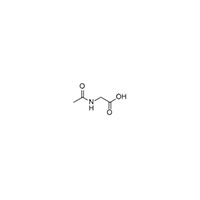Synonyms
N-acetyl-Gly
ACETYL-GLYCIN
Aceturic acid
N-Acetylglycine
CH3CONHCH2COOH
Glycine, N-acetyl-
ACETYGLYCINE
acetylaminoacetic acid
Ethanoylaminoethanoic acid
N-Ac-Gly-OH
ACETYL-GLYCINE
ACETOGLYCINE
MFCD00004275
AC-GLYCINE
N-acetyl-glycine
Product Description
Introduction:
N-Acetylglycine, also known as Acetyl Glycine or N-Acetyl Aminoethanoic Acid, is a chemical compound
derived from glycine, an essential amino acid. It is widely used in various industries, including
pharmaceuticals, cosmetics, and food additives. N-Acetylglycine offers several beneficial properties and
applications due to its unique chemical structure.
Raw Materials:
N-Acetylglycine is produced by the acetylation of glycine using acetic anhydride or acetic acid as the
acetylating agent. Glycine, the primary raw material, can be obtained through chemical synthesis or
fermentation processes. Acetic anhydride or acetic acid, a common reagent, is used to introduce the
acetyl group to the glycine molecule, resulting in N-Acetylglycine.
Production Process:
The production of N-Acetylglycine involves the careful combination of glycine and the acetylating agent
under controlled reaction conditions. The acetylation reaction is carried out using appropriate
catalysts and reaction parameters to ensure a high yield and purity of the product. The resulting
N-Acetylglycine is then subjected to purification techniques, such as crystallization or chromatography,
to obtain a refined and stable form.
Market Trends:
N-Acetylglycine has gained significant attention in various industries due to its multifunctional
properties. In the pharmaceutical industry, N-Acetylglycine is utilized in the synthesis of certain
drugs and as a potential therapeutic agent for conditions related to neurological disorders and
oxidative stress. In the cosmetics industry, it is incorporated into skincare formulations for its
moisturizing and skin-conditioning effects. Additionally, N-Acetylglycine finds application as a food
additive, providing taste enhancement and serving as a precursor in flavor synthesis.
Amino Acid Status:
Glycine, the precursor to N-Acetylglycine, is a non-essential amino acid that plays a vital role in
various physiological processes, including protein synthesis, neurotransmission, and detoxification. The
acetylation of glycine enhances its stability and bioavailability, allowing for greater utilization in
different applications. N-Acetylglycine's incorporation into various products expands the range of
benefits and applications associated with glycine.
Conclusion:
N-Acetylglycine is a versatile compound derived from glycine, offering a wide range of applications in
the pharmaceutical, cosmetics, and food industries. Its production involves the acetylation of glycine
under controlled conditions, ensuring consistent product quality. With its multifunctional properties
and diverse applications, N-Acetylglycine continues to attract interest from various industries. As
research and development in amino acids advance, N-Acetylglycine's potential benefits and applications
are expected to expand, contributing to the advancement of pharmaceuticals, cosmetics, and food
formulations.





